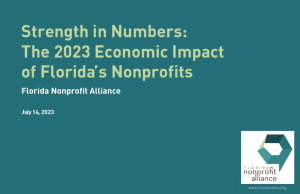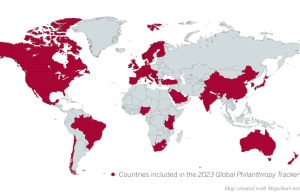By Kerri Kerr
The first donor-advised fund (DAF) accounts date to the 1930s, began growing in earnest during the 1990s, and were formalized in the Pension Protection Act of 2006. In fiscal year 2021, more than 1.2 million DAF accounts in the United States granted a combined $45.74 billion for a year-over-year increase of 28.2%. During the same period, contributions to DAF accounts grew by a whopping 46.6% to $72.67 billion.
DAFs have without question become an established and growing philanthropic vehicle. What is the best way for nonprofits to harness DAFs’ power? Most importantly, nonprofit leaders should embrace DAFs as a vital source of fundraising.
While DAF giving might replace a previously direct gift a donor made, it would be a mistake to consider DAFs a competitive threat to direct giving. Rather, they are an exciting opportunity. The obvious benefit is the grant itself, but DAFs are also an important tool for cultivating and re-soliciting high-potential donors. In addition, DAFs can be a powerful source of unrestricted funding.
Some experts have criticized donors using DAFs as a way to postpone grants since they do not legally require a payout. By contrast, private foundations have a 5% minimum required payout. However, according to the Stanford Law School Policy Lab on Donor Advised Funds, the average DAF payout rate has been significantly more than the average private foundation payout. In addition, the authors suggest DAFs might have a “smoothing effect” that stabilizes nonprofit funding during economic downturns. Because donors can put funds in their DAF when it is advantageous to them and then grant later, DAF grants are uniquely positioned to weather economic volatility.
Fundraisers should embrace DAF donors. Do not let the vehicle of the DAF obscure the people behind these grants. Much of the advice on DAFs does the opposite. Experts focus on funds and depersonalize donors.
Fundraisers must remember that DAF donors are human beings making personal giving choices. Fundraisers should build relationships with them directly.
It will sometimes be difficult to do because of fund rules. When that is the case, invitations for donors to self-report will be important. Anything you can do to break down that barrier is critical. Once you have your donors’ information, you can engage with them as you would any other donor on your file — as a generous human being who cares about your cause and has a specific giving history.
For these reasons, fundraisers should promote the value of DAFs for donors. There are many benefits, including immediate tax deduction for a range of gifts, including cash, publicly traded securities, complex assets and new categories like non-fungible tokens (NFTs). Donors can give when they are able and grant later when need arises. DAF funds grow tax-free between gift and grant. In addition, DAFs provide donors with philanthropic infrastructure and expertise that otherwise can be hard to access. This simplifies recordkeeping, augments legacy and estate planning, and amplifies impact.
But, Wait ….
There might also be times when a DAF is not the right approach. Donors who wish to retain maximum freedom over distribution might be a better match for individual giving or a private foundation. Donors should be aware of minimum contribution thresholds and how their fund will accrue investment and/or administration fees.
Transparency about these pros and cons will strengthen your relationship with your donor and help ensure that every donation makes an impact.
Use all fundraising channels to promote, educate and invite donors to implement DAF giving. Websites, acknowledgements, and planned giving campaigns are particularly ripe for this kind of message. Consider adding a free widget from DAFwidget.com or DAFDirect.org to your website. Recognize DAF donors, include DAF giving as a payment type, and tailor your ask string to include an option for initiating a grant to your organization. At every step, be specific about the kind of DAF support that your organization prefers, such as scheduled or reoccurring grants. If you don’t ask, they won’t know to specify.
Be aware that DAF giving can originate across the recency spectrum. Unless the data tells a different story for your organization, don’t limit yourself to the new donor pool. Analysis at one arts organization showed that while 16% of DAF revenue sourced to new joins the largest segment of revenue came from members who had been with the organization for more than 20 years. In addition, there was strong activity at every recency between those extremes.
There are a few things to remember after a DAF contribution. Collect donor information wherever possible and be sure to say thank you. Many fundraisers steward DAF donors at high giving levels with handwritten notes. These and other high-touch tactics can help move DAF donors up the fundraising pyramid. Like any donor, DAF donors with high giving potential should be cultivated towards major and planned giving.
It is also important to explain and follow Internal Revenue Service (IRS) rules related to benefits. For example, donors may recommend a grant to cover the cost of a membership to a charitable organization. However, the cost of the membership must be 100% tax-deductible. This means that donors cannot receive membership benefits that are more than incidental. This may be a surprise to long-time members of your organization, so transparency and intentional communications will be important.
Become an expert on all stages of your nonprofit’s DAF giving. It is important to track DAF data today, so you can leverage future opportunities. Capture donor information wherever possible and code DAF gifts properly, giving hard credit to the institution issuing the grant and soft credit to the donor directing the grant. Track all DAF revenue and understand how it changes over time.
Specifically, you should track total DAF revenue, DAF revenue as a percentage of total giving, and how those numbers change over time. Assess whether DAF revenue is new and growing or shifting from other types of giving. Note trends in donor composition and understand how they affect DAF revenue.
Conduct match-back analysis to understand the flow of subsequent donations and upgrades. Match-back information provides a fuller picture of how DAFs contribute to your nonprofit’s bottom line. In addition, it guides campaign strategy to maximize future giving.
Pay attention to national trends. The National Philanthropic Trust produces an annual report that aggregates national DAF activity. In the 2021 report (covering fiscal year 2020), researchers accurately projected rapid growth in DAF grants for fiscal year 2021. They also projected growth in contributions to DAFs, which held out and then some. They did not anticipate that contributions would grow at their fastest rate ever.
For fiscal year 2022, the National Philanthropic Trust projected continued growth, although the outlook was tempered by broad economic challenges. Though it is too early for final analysis, this projection seems reasonable. Major funds reported continued growth at mid-2022, despite a stressed economy.
Finally, remember your donors truly want to give. These trends bode well for the future of DAFs and are a clarion call to fundraisers to pursue this type of funding.
As always, if you don’t ask, donors will not give. So be sure to solicit DAFs as strategically and enthusiastically as you would pursue individual giving. Fundraising at its best empowers donors to give generously to the causes they care about. DAFs are no exception.
xxxxx
Kerri Kerr is chief operating officer at Avalon Consulting Group. Her email is [email protected]











